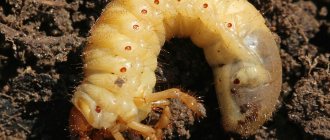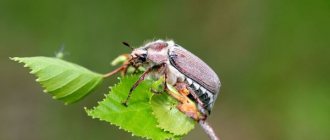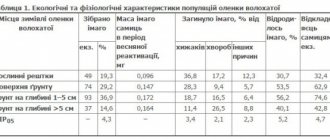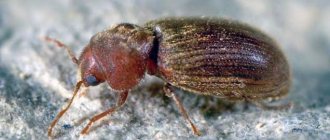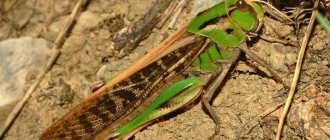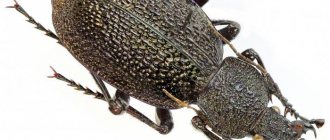- 68825
- bronze insects
Bronze beetles (Cetoniinae) are a subfamily of beetles belonging to the family Scarabaeidae. Includes five subspecies, which differ from each other in appearance and range. Within each subspecies, several forms are distinguished, differing in color and the presence or absence of hairs. These beetles are distributed throughout Eurasia, except for desert and mountain regions.
The bronze beetle is often mistaken for an ordinary cockchafer, since they belong to the same family. These insects can be distinguished by their bright metallic color and flight. When flying, the hard elytra of bronze beetles remain folded, unlike most beetles, and thin transparent wings are released through recesses on the sides. Therefore, despite their size, these beetles maneuver well in the air.
The most common are golden bronze, shaggy bronze and small green bronze.
note
Smooth bronzewort (Protaetia aeruginosa) and marbled bronzewort (Protaetia marmorata) are listed in the Red Book of the Moscow Region.
Damage caused by bronze
Bronzovka is a typical forest dweller, preferring sunny glades. Due to their frequent visits to garden plots in search of food, they are recognized as pests. The beetles are very voracious, destroying flowers of fruit and berry and ornamental crops, sucking juices from plants, leaving behind yellowed areas, and nibbling leaves. If beetles get into houses, they begin to eat indoor plants.
The damage caused by the bronze beetle to garden plots is that this beetle feeds on:
- flowers of fruit and berry and ornamental plants; they often eat young fruits of fruit crops;
- ovaries of cabbage, carrots, that is, parts of a plant or fruit containing seeds;
- beet leaves.
note
The beetles completely gnaw out the stamens and pistils - the reproductive organs of plants located inside the flower, so their pollination and fertilization becomes impossible, which means the ripening of fruits and seeds is also impossible.
At the same time, ornamental plants cease to perform their function, acquiring a nondescript appearance and losing their aroma.
Description of the pest
The stinking/spotted bronze beetle, or stinking/spotted deer (Oxythyrea funesta/cinctella) is a beetle belonging to the family Scarabaeidae. This pest is widespread, but the largest number of its populations is observed in the zone of steppes and forest-steppes. Flower meadows, especially those with calcareous soils, are also attractive to this beetle. Among the favorite delicacies of the stinking bronze beetle, flowers of fruit trees (mainly apple, pear, peach, cherry), field crops (rapeseed, sweet clover), as well as ornamental plants (rose suffers more than others) occupy a place of honor.
If everything is clear with the rather prosaic name of bronze, which indicates a spotted color, then there is currently no unanimous opinion regarding the emergence of another (unsightly) name. Some researchers believe that it is due to the fact that, after holding the beetle in your hands for some time, you can feel the unpleasant odor emanating from the pest. Others see the name as a mistranslation of the Latin word “funestus,” which means “mourning, tragic,” rather than “smelly, fetid.”
The stinking bronze is notable for its shiny black coloration with white spots on the sides, back and elytra. The size of the body, which is usually covered with short light hairs, is 8-13 mm. It should be noted that some older individuals have no hairs, as they wear off over time. The peculiarity of this beetle is that during flight it does not raise its elytra, but spreads its wings through a special hole.
Females of the stinking bronze fly lay their eggs in fertile soil, with particular preference given to lands with a large amount of humus. After about 2 weeks, larvae emerge from the eggs (reach a size of 30 mm), which feed on dead plant roots, but they do not cause much harm. Flight occurs in May-July. During the day, adult individuals feed on the pollen of flowers, their leaves and petals, sometimes completely eating the stamens and pistils, thereby often causing very significant damage to plants. The plant not only loses its decorative effect, but also stops developing. Fruit crops may subsequently fail to produce a harvest at all. In autumn, with the onset of cold weather, the beetle hides in the soil and remains there for the winter, and next spring it comes out again to feed on flowers.
Measures to combat bronze blight
Until now, there are no exact instructions on how to get rid of bronze, since until recently, it did not pose a big threat. Some believe that these beetles cannot cause much damage to crop plants due to the late summer when most of them bloom.
Damage to plants is caused by adult bronze beetles. But you need to start fighting with the larvae.
The larvae of these beetles live in rotten wood or in piles of humus, therefore, if you periodically get rid of such wood and clean your area from fallen leaves and fruits, the likelihood of adult beetles appearing will be significantly reduced. On the other hand, the larvae process plant residues, contributing to the formation of a fertile soil layer
Features of bronzes
In the classifier of insects, the bronze is located in the order Coleoptera in the family Lamelidae. Its scientific name, Cetonia, is translated from ancient Greek as metal beetle. In fact, these insects are black, but if you examine their integument under a microscope, you can see their complex structure. Rays of light are refracted in microscopic irregularities, creating an unforgettable play of shades and tints.
Beetles try not to waste energy - they can sit for a long time on one flower, where they have “both a table and a home.” In cool, damp weather they hardly move at all , waiting for a hot sunny day to fly to another place. Bronze birds fly quickly, but sometimes they crash into obstacles and fall on their backs. In this position, the insect is most vulnerable: since it is difficult for it to roll over, this process takes a lot of time.
Almost all species of beetles fly slowly, as the raised elytra create strong air resistance.
Nature gave bronze beetles an unexpected gift: they have special cutouts through which the beetle releases its thin wings and takes flight. At this time, the rigid elytra lie on the back and do not interfere with rapid movement.
Ways to fight
Methods for getting rid of bronze are not very different from generally accepted pest control methods:
- Collecting and shaking off beetles by hand. For relief, you can spray the plants with cold water, which makes the bronzes fall into a stupor. After shaking off, you need to place them in a container with kerosene. This method is not particularly effective, since the destroyed bronzes will be replaced by others;
- Spraying with decoctions and infusions of herbs that repel pests, for example, dandelion, tansy, wormwood, garlic, horseradish, onion, etc.
- You can use pesticides by adding them to the soil to a depth of 3-5 cm at night, since beetles hide in the ground at night;
- Plowing the soil after winter will destroy the beetles that are in the soil during this period
What are the types?
On the territory of Russia there are 5 subspecies of bronzes. They all have characteristic features. The main difference is the presence of a gun or its absence.
The main types of insects are presented in the table.
| Smooth | The length of the insect reaches 30 mm. Has a rich green color. Probably the presence of blue and pink tints. It is localized mainly near old trees. |
| Smelly | This representative has a black color with whitish markings. They live in the southern zones of Russia. The length of the body is a couple of centimeters. The insect has villi. Emits an unpleasant odor. |
| Marble | Bronzeweed grows up to 3 cm. The color is black and white. The lines are uneven. |
| Gold | Has a pronounced yellow color. The length does not exceed 2.5 cm. They are localized in gardens and vegetable gardens. They prefer black soil. |
All of the listed subspecies are found on the territory of Russia. Outside the country, you can often see the Congolese bronze. The beetle can be yellow, orange, or have a reddish tint.
All tropical subspecies have a short life cycle. Some representatives live only a few months.
Marble bronze
Protaetia marmorata (Fabricius, 1792) Order Coleoptera, or Beetles - Coleoptera Family Lamellaridae - Scarabaeidae
Status.
Category 2 - a rare species in Moscow with a declining population. Listed in the Red Book of the Moscow Region (1).
Spreading.
In the Moscow region. distributed sporadically, although quite common in habitats (2). On the territory of Moscow in 1985-2000. The species was recorded in Losiny Ostrov (3), Izmailovsky Forest (4), Kuzminsky Lake (5), on Vorobyovy Gory (4), in the SBL near Troitse-Lykov (6), on the territory of the Moscow Agricultural Academy and in Ostankino (4). During the revision period, it was discovered in Kuskovo Lake in 2009 (7), south of us. “Znamenskoe-Sadki” in 2004 (8), in Trinity Lake (9) and on Vorobyovy Gory in 2005 (4).
Number.
Within Moscow it is rare and occurs only sporadically.
Habitat features.
Inhabits deciduous and mixed forests, as well as gardens. It gravitates towards old stands, inhabits large dead trees and stumps of oak (preferred species), linden, willow, aspen and other deciduous species. The larvae develop in the hollow substrate or rotten wood, where they pupate (2, 10). In Moscow conditions, generation is mainly two-year-old (3). Flight of adults is from June to August. The beetles additionally feed on sap-bearing trees, less often on flowering plants (wort, elderberry, rose hip, etc.); They fly well. The species is an active destroyer of dead deciduous wood in the final stages of destruction and promotes soil humification. An indicator of the preservation of a characteristic complex of invertebrate animals - destroyers of dead wood.
Negative factors.
Cutting down old hollow and hollow trees in urban forests, complete removal of dead wood and natural waste, uprooting of stumps.
Security measures taken.
In 2001, the species was listed in the Red Book of Moscow with KR 3. Known, incl. its habitats, unconfirmed during the audit period, but not lost, are located in protected areas - in the Losiny Ostrov NP, Izmailovo P-IP, Kuzminki-Lublino, Bitsevsky Les, Moskvoretsky and Ostankino, PZ " Vorobyovy Gory", LP "Tyoply Stan" and KZ "Petrovsko-Razumovskoye". It is planned to create P-IP "Kuskovo" and PZ "Troitsky".
Change the view state.
Confirmation of the species' habitat in only one of seven previously known places and only three new finds during the revision period, combined with the continued action of limiting factors, indicate that the marbled bronze is becoming more rare in Moscow. The type CR changes from 3 to 2.
Necessary measures to preserve the species.
Priority formation of the Kuskovo P-IP with the allocation of high-age oak trees to the Troitsky ZU and PZ. Maintaining urban forests on their main area in a state close to natural - preserving old, hollow and sap-bearing trees (especially oaks), natural waste and large dead wood, limiting the removal of dead wood to the removal of emergency trees; establishing a ban on uprooting stumps and filling hollows. Special searches for the species in previous habitats and identification of new ones; if they are detected, they are allocated to the reserves, the regime of which provides for the listed measures.
Information sources.
Red Book of Moscow. 1. Red Book of the Moscow Region, 2008. 2. Nikitsky et al., 1996. 3. N.B.Nikitsky, l.s. 4. Author's details. 5. V.B. Beiko, l.s. 6. M.Yu.Mironov, l.s. 7. A.A. Benediktov, fees. 8. P.V.Korzunovich, photo, l.s. 9. A.P. Mikhailenko, fees. 10. Medvedev, 1964. Author: A.V. Kompantsev
AOF | 04/02/2015 09:32:06
Back forward
Reproduction and lifespan
When it is time to mate depends on weather conditions. If they are favorable, the bronzes will mate and the female will lay 15-20 eggs. She does this in rotten stumps, compost heaps, and anthills. Bronze larvae develop from the eggs .
Over time, they build a cocoon around themselves, gluing together leaves and pieces of wood with their secretions. What gender the children will turn out to be depends on the ambient temperature. If it is too cold or hot, only males or only females will hatch from the cocoons. The insect fully matures only after 2-3 years.
Appearance
As already mentioned, the bronze beetle is a very beautiful beetle. It is divided into various species and belongs to the coleopteran insects of the subfamily of bronzes. The seven main subspecies of this insect have different colors, body sizes, feed differently and have different habitats.
But almost all of them have a shiny, metallic color of various shades. Species names are also determined primarily by color. So, for example, the golden bronze mainly has a golden greenish sheen on the back, while its belly is red with a green tint.
In the photo there is a golden bronze
This species is 15-20 mm in length. Green bronze has a bright green metallic sheen and a smaller size - up to 20 mm.
In the photo the bronze coat is green
Another small species is the hairy bronze, its entire black body is covered with gray or yellow hairs.
In the photo there is a shaggy bronze cat
Marble bronze does not have the usual golden shine; it is dark, almost black with a green tint, and has spots on its back.
The photo shows a marble bronze
This is the largest species, reaching a length of 27 mm. Typically, all shiny species have green legs and black whiskers. The head is most often covered with thin, sparse hairs; the elytra have a thin white pattern.
Externally, the bronze beetle can be confused with the cockchafer, because they are from the same family and are really very similar. The difference from many other beetles is the ability of bronze beetles to maneuver maneuverably, which is possible thanks to the elytra folded in flight. Transparent flight wings come out from the sides.
Feeding broncos
Adult beetles (imago) are fed with pieces of ripe and overripe fruits (oranges, tangerines, bananas, apples, pears, plums, peaches, apricots). From vegetables you can give carrots, pumpkin, zucchini. Some hobbyists feed small amounts of kibble dog food. In the summer, offer beetles flowers of dandelion, rose hips, roses (but not those sold in flower shops - they are treated with chemicals). It is not recommended to feed cereals - they spoil quickly and insects get dirty in them. Place food not on the ground, but in feeders or pieces of bark.
The larvae use decaying leaves to feed. They can also add pieces of fruits and vegetables.
Lack of food can lead to beetles with various defects, sometimes not suitable for further breeding.
Nutrition
Smooth bronzes begin to become active between May and September. The main food of these representatives is various tree sap. Therefore, as a rule, these insects prefer to inhabit places with a large number of trees that have damaged bark, since a lot of liquid accumulates in them. In addition to juices, smooth bronze beetles can consume overripe fruits.
Description
The beetle is 19–27 mm long. The color is shiny, black-bronze, the underside of the body and legs, especially the metathorax, have a strong greenish tint; sometimes the elytra or the entire upper side also have a greenish tint. The body is elongated, somewhat narrowed posteriorly, moderately convex. The clypeus is elongated and rectangular. Head in large and deep points. The pronotum is weakly transverse, wide at the base, tapering forward. Covered with small dots, on the sides in dense large arcuate dots. The scutellum is large, elongated triangular, with a blunt apex, with small points. The elytra are elongated, somewhat narrowed posteriorly. Pygidium moderately convex. The abdomen of the male has a longitudinal groove.

